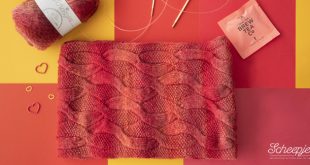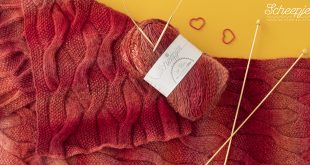
One thing I’ve wanted to try for a really long time is dyeing my own wool. I think it’s a bit of a natural progression, getting into knitting or crochet, then spinning and once you get into all of that dyeing is never far behind. For many who get into fiber arts, I have become curious about mostly every aspect of it. I even bought the fleece of an entire alpaca so I can learn how to prepare and spin it… but that’s a post for another day.

At the moment, the area of France I’m living in (the Limousin) is blanketed with dandelions and I thought this was the perfect chance to have a go at some natural dyeing! With the helpful advice of my friend Jan from Spindletree and this useful tutorial I gathered up the materials I needed and gave it a go.

I had a few skeins of wool that I had spun with the purpose of using it for dyeing. I’m not sure what wool it is exactly as I was gifted 1kg of it when I got my wheel, but it is really lovely and feels nice. I picked a ton of dandelion flowers from our veggie patch which hardly even put a dent in the amount we had there. I wasn’t really sure how much I needed, but I figured more is better. It was an average sized mixing bowl full to the top, which, when I poured it out into the pot, almost filled that too.

As it turned out in the end I probably had quite a lot more than was needed because the dye water is still almost the same colour after I finished as it was when I started. I’ve saved it to see if I can dye more with it later, I just need to figure out how to save it. I’m wondering if you can freeze dye solution, that would be the best method for me right now. I may also get a big jar and try some solar dying in my polytunnel since people seem to have good results with that here in the summer. There are so many fun options!
To be honest, when I saw the colour of the water after I took the dandelions out, I was pretty sure I was going to end up with green rather than yellow! It was such a dingy, yucky greenish brown colour.

The most daunting part for me was the mordant. Whenever I’ve thought about doing natural dyeing (or any dyeing, really) the whole mordant thing really intimidated me. I found it so confusing! All these different things you can / should add to the water, the ways they change the outcome, it was all so darn complicated! In the end I decided to do what I tell new knitters to do – take it one project and one step at a time and don’t let yourself become too overwhelmed by trying to take everything in at once.
The tutorial for dyeing with dandelions suggested Alum as the mordant, so that’s what I got. It wasn’t available in the supermarkets the way a lot of sites suggest, at least not here in France. In fact, I actually found it kind of difficult to get my hands on. I ended up ordering 1kg of it from Amazon and figured that would do me for a long, long time.
I just happened to have the same amount of fiber as in the tutorial, so I just went ahead and used 1 tsp and hoped for the best. I didn’t mix it with separately with boiling water before adding it to the pot like a lot of websites suggest, because I only noticed that advice later. When I put it in the cold water it didn’t really break down so I had to mix and poke at it a lot with the wooden spoon. Next time I’d mix it with the hot water first just to make life easier.
My biggest worry when simmering the yarn with the mordant was that it was going to boil too hard and felt the yarn. There were so many warnings about it on the different tutorials that I was sure it was going to boil too high without me noticing and that I would end up with a greenish coloured felted brick! Thankfully that didn’t happen.

After letting the yarn cool down in the mordant water, I removed it and added it to the dye bath, then brought it back to a simmer. I let it ‘cook’ there for about an hour, which felt like forever because I continued to be up and down every five minutes as I obsessively checked to make sure it wasn’t boiling too much.
Once I saw the yarn in there, I was a relieved to see that the dye bath actually was just a really strong yellow colour rather than green or brown. This is when I started getting pretty excited about it.
After the yarn was finished cooking, I turned the burner off and waited until it cooled off to room temperature. Then I strained it and set aside the leftover dye (which, as I mentioned, was STILL looking dark green!) and gave it a gentle wash with some detergent. After a good spin in my salad spinner (which has joined the ranks of ‘shall not be used for food’ with the other utensils I used) it was ready!

OMGOMGOMG – I DYED A THING!
This is what the yarn looked like after I spun it out. It’s still wet in the photo but it looks the same now that it’s dry anyway. I was too excited to wait to take a photo. I am so stoked with how it worked out and it was so much fun. I actually dyed yarn that I spun with my very own hands and that’s such so freaking cool! Now I want to dye all the things, all the colours, from all the plants!
I noticed that there was also a tutorial on the same website for dyeing with black beans, which I happened to have in the cupboard. They have been soaking in a bowl since yesterday morning, so that will be my experiment later today. I will report back!



How am I only discovering your blog today? Shame on me. I was tempted to start beheading dandelions around London when I visited last year. I love dyeing with them, gives a really soft yellow. I have no access to fresh plant dyes here in Dubai but luckily a friend in Denmark forages for the both of us and she shares her bounty with me.
I tried this yesterday after seeing the post by spindletree! I used vinegar as my mordant as I read that gives a more yellow tone to the finished product. I also read that an alkaline dye bath makes most flower dyes more vibrant, so I bunged in bicarb until it stopped fizzing. I assume that dandelions are acidic. My dye bath went a very dark yellow. The resulting wool for me… well I would describe it as urine stained yellow… other people have told me it is a light honey. I’ll have to have another to using a different mordant and not alkalising my dye bath! I love the subtle changes you can make to dye bath and the very dramatic changes in the finished product!